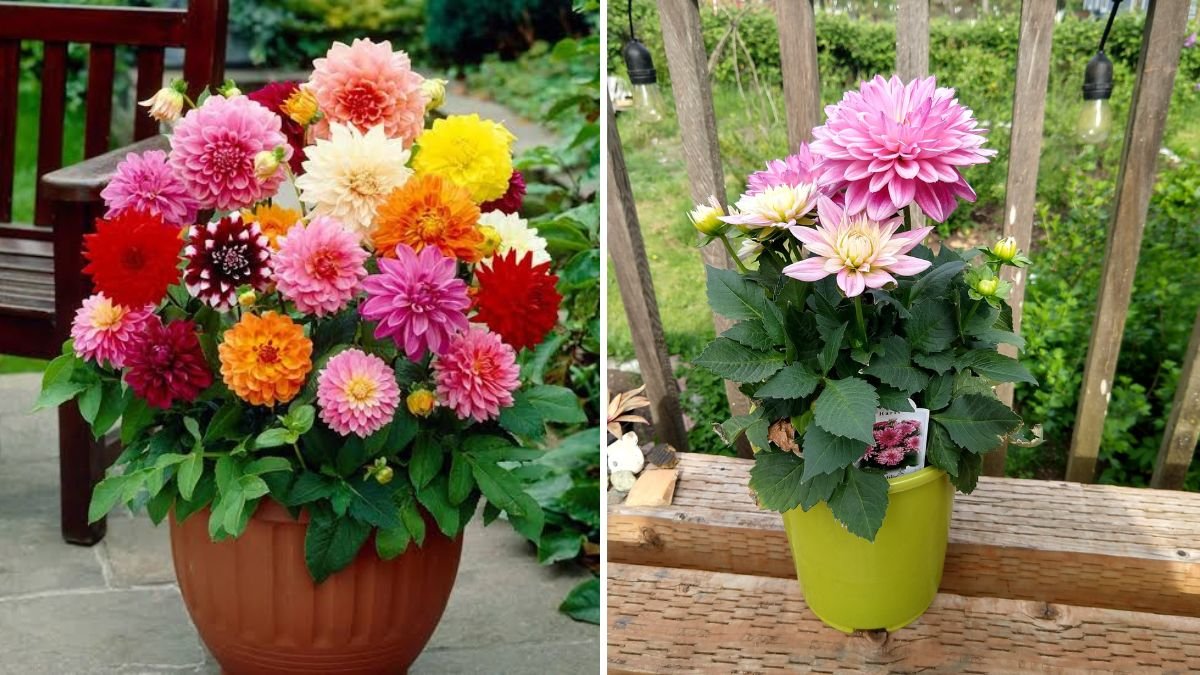Dahlias are striking, versatile, and colorful flowering plants that can transform any garden or balcony into a vibrant display. Known for their bold blooms, intricate petal formations, and wide range of colors, dahlias are a favorite among gardeners seeking eye-catching floral arrangements. While traditionally grown in garden beds, dahlias can also thrive in pots and containers, making them perfect for small patios, balconies, rooftop gardens, or urban spaces.
This guide explores everything you need to know about growing dahlias in pots, including variety selection, potting techniques, soil preparation, watering, fertilization, pruning, pest management, and seasonal care to achieve lush, healthy blooms in compact spaces.
Step 1: Selecting the Right Dahlia Varieties for Containers
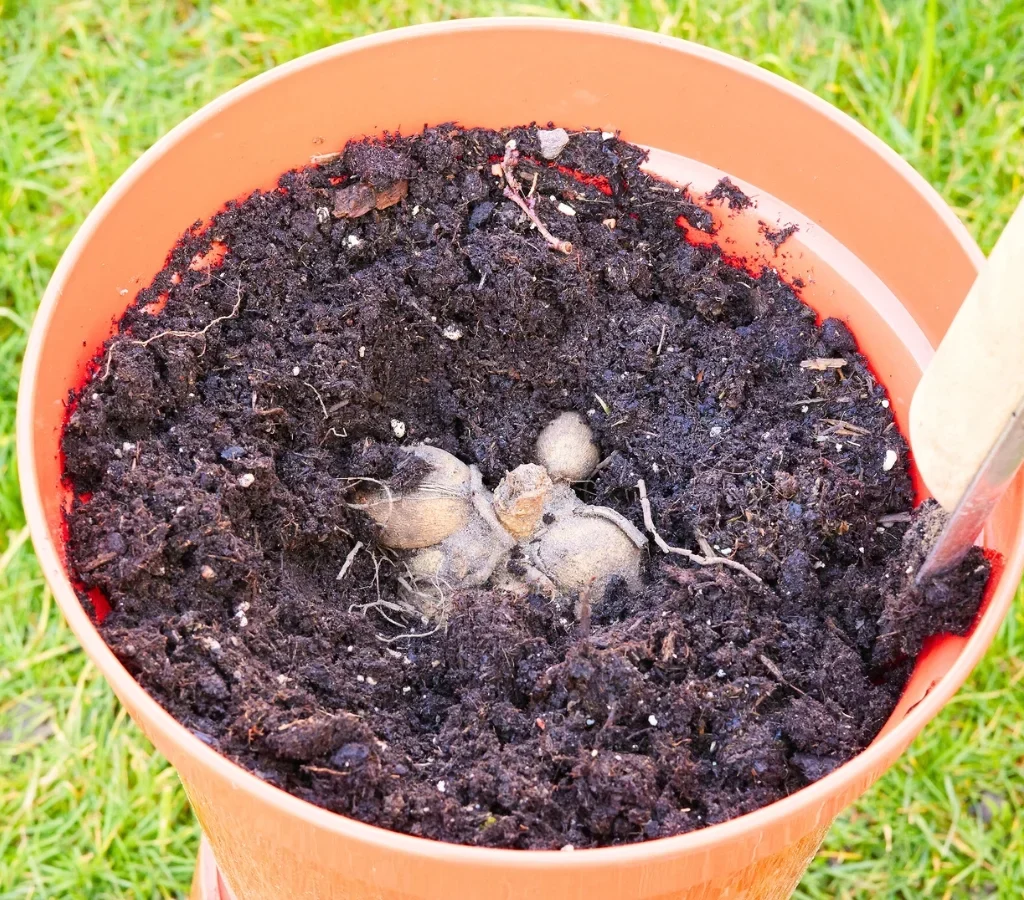
Not all dahlias are suitable for container growing. Choosing compact or dwarf varieties ensures plants remain manageable and thrive in limited space:
- Miniature or Small-Flowered Dahlias: Ideal for pots; flower sizes range from 2–4 inches.
- Bedding Dahlias: Medium-sized plants that grow up to 18–24 inches; suitable for larger pots.
- Decorative and Pompon Dahlias: Produce rounded blooms; dwarf versions work well in containers.
Tip: Avoid giant dahlias in small pots, as they require deep soil and extensive space to support heavy blooms.
Step 2: Choosing the Right Pot
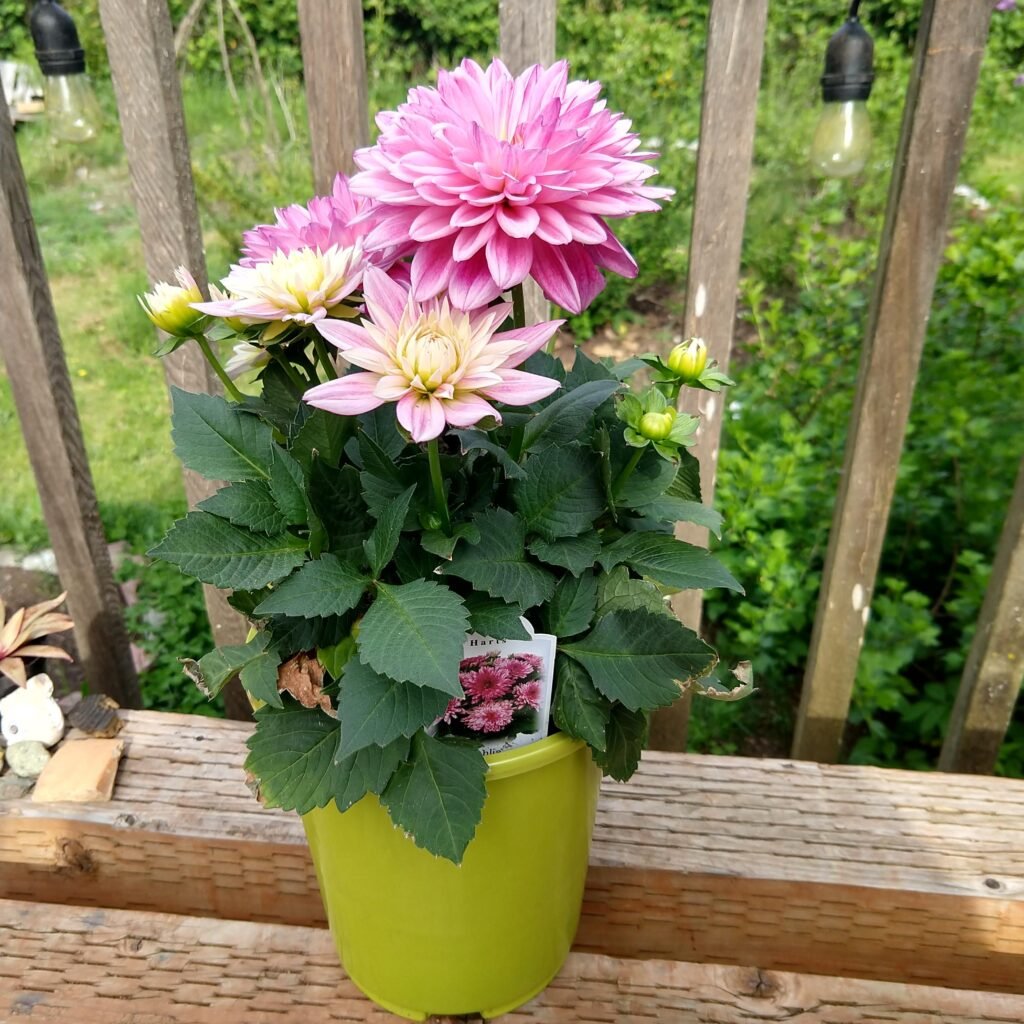
Pot selection is critical for container-grown dahlias:
- Size: A minimum of 12–16 inches in diameter for small varieties; larger varieties may need 18–24 inches.
- Depth: At least 12–16 inches to accommodate tuber growth.
- Material: Terracotta, ceramic, or plastic pots are suitable; terracotta provides breathability but dries faster.
- Drainage: Ensure adequate drainage holes to prevent waterlogging and tuber rot.
The right container promotes healthy root growth, reduces disease risk, and ensures stable plant growth.
Step 3: Preparing the Soil
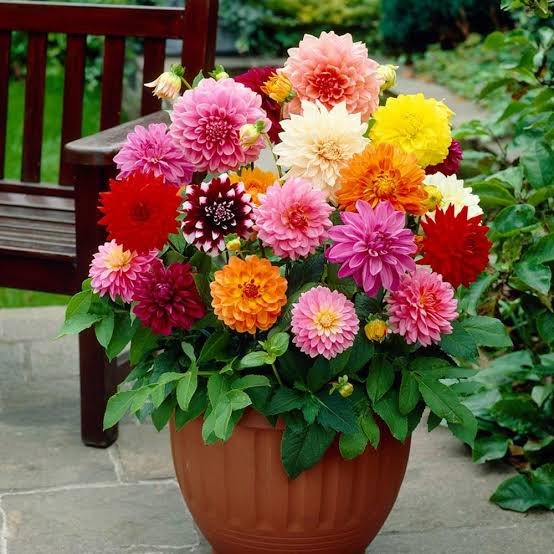
Dahlias require nutrient-rich, well-draining soil for optimum growth:
- Soil Mix: Combine equal parts of garden soil, compost, and coarse sand or perlite for drainage.
- pH Level: Slightly acidic to neutral soil (pH 6–7) works best.
- Fertilizer: Mix a slow-release balanced fertilizer into the soil to provide nutrients throughout the growing season.
Proper soil preparation ensures strong roots, vibrant foliage, and abundant flowering.
Step 4: Planting Dahlia Tubers
Planting tubers correctly is essential for healthy container growth:
- Timing: Plant in spring, after the danger of frost has passed.
- Orientation: Place the tuber horizontally with the eye (growth bud) facing upward.
- Depth: Cover with 2–3 inches of soil initially; as shoots grow, gradually add more soil to support stems.
- Spacing: One tuber per pot is ideal for small containers; larger pots can accommodate 2–3 tubers spaced evenly.
Careful planting ensures strong shoot emergence and robust flowering.
Step 5: Watering and Fertilization
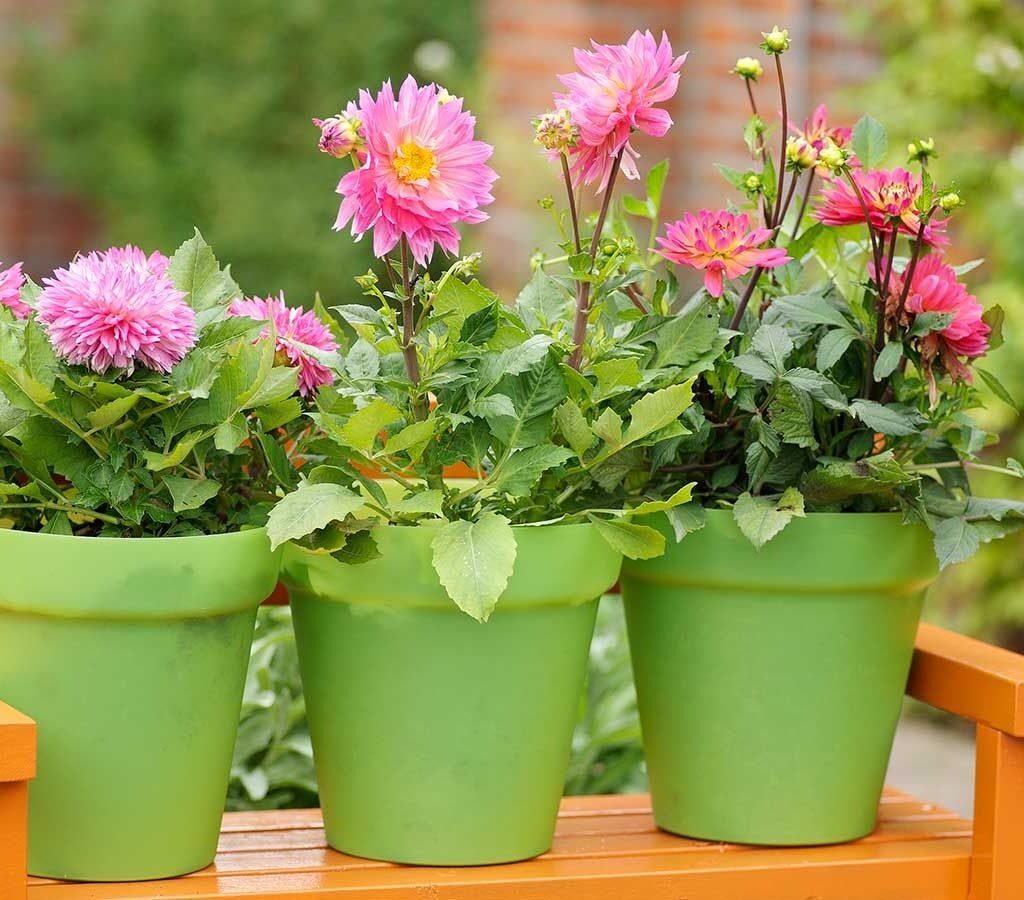
Dahlias in pots have specific water and nutrient requirements:
- Watering:
- Water thoroughly after planting.
- Once shoots appear, maintain even soil moisture, avoiding waterlogging.
- Container soil dries faster; monitor moisture daily during hot weather.
- Fertilization:
- Use a low-nitrogen, high-phosphorus fertilizer to encourage strong blooms rather than excessive foliage.
- Feed every 3–4 weeks during the growing season.
- Organic options like compost tea or fish emulsion work well.
Proper watering and fertilization support continuous flowering and overall plant health.
Step 6: Providing Support for Stems
Some dahlia varieties, even in pots, produce tall or heavy blooms:
- Stakes or Cages: Insert a bamboo stake or small cage at planting to support stems.
- Tying Stems: Use soft ties to secure stems to stakes, preventing breakage in wind or from heavy flowers.
- Regular Inspection: Adjust ties as plants grow to avoid restricting stems.
Supporting stems prevents damage and ensures blooms remain upright and visually appealing.
Step 7: Sunlight Requirements
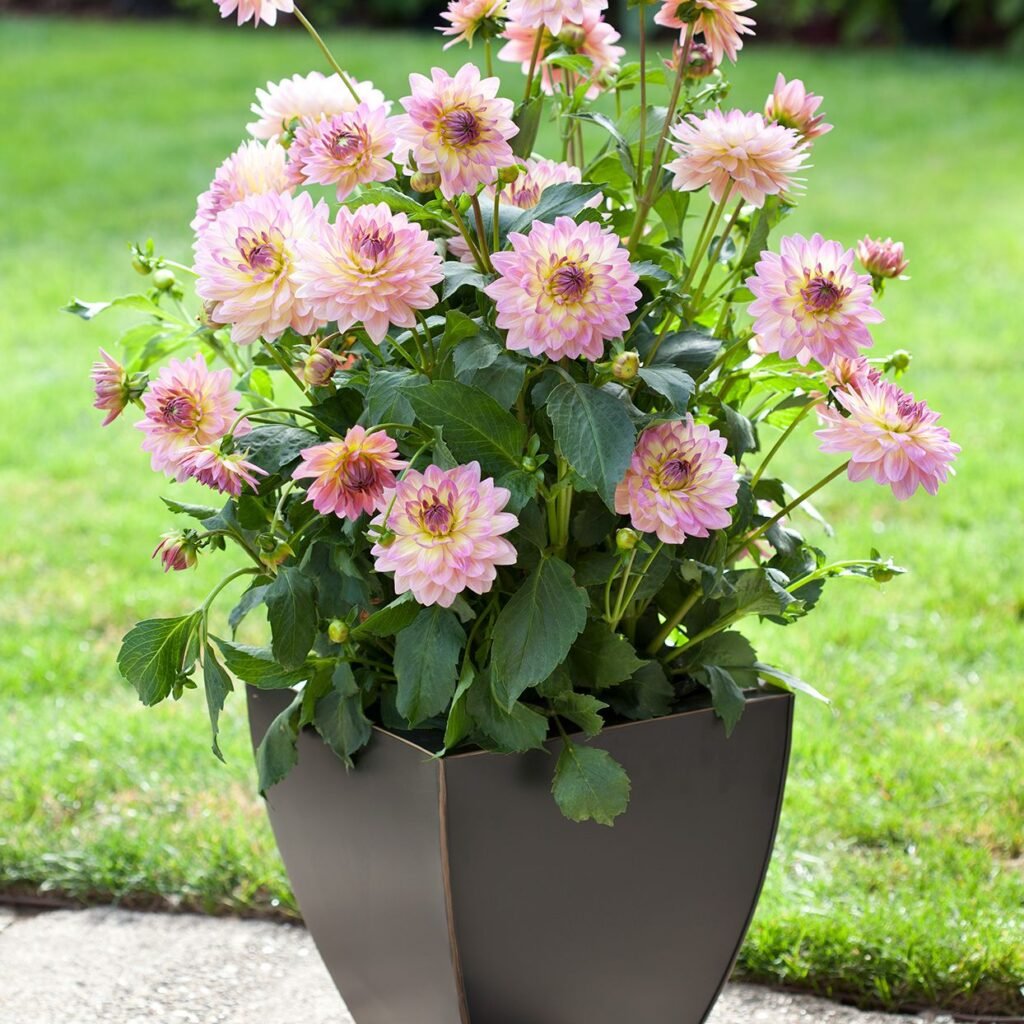
Dahlias thrive in full sun:
- Light Exposure: 6–8 hours of direct sunlight daily is ideal.
- Container Placement: On balconies or patios, rotate pots to ensure even growth.
- Partial Shade: In extremely hot regions, light afternoon shade can prevent scorching.
Adequate sunlight promotes strong stems, vibrant colors, and extended flowering.
Step 8: Deadheading and Pruning
Regular deadheading and pruning encourage prolonged blooming:
- Deadheading: Remove faded or spent flowers by cutting just above the first set of healthy leaves.
- Pruning: Trim any damaged, diseased, or excessively long stems to maintain shape.
- Pinching: For bushier growth, pinch out growing tips early in the season.
These practices stimulate new blooms and maintain compact, attractive plants.
Step 9: Pest and Disease Management
Potted dahlias can be vulnerable to pests and diseases:
- Common Pests: Aphids, spider mites, slugs, and caterpillars. Control with insecticidal soap, neem oil, or manual removal.
- Diseases: Powdery mildew, fungal leaf spots, and tuber rot. Ensure good air circulation, avoid overwatering, and remove infected leaves promptly.
- Preventive Care: Keep pots elevated or on trays to prevent waterlogging and monitor plants regularly.
Proactive management reduces stress on plants and ensures vibrant blooms.
Step 10: Overwintering Dahlias in Containers
In cooler climates, dahlias in pots require special care over winter:
- Lifting Tubers: After the first frost, cut back stems, remove tubers from soil, and allow to dry.
- Storage: Store tubers in peat moss or sand in a cool, dry, dark location.
- Replanting: In spring, replant tubers in fresh soil for a new cycle of blooms.
For mild climates, mulching pots and leaving tubers in place can be sufficient, protecting them from frost.
Step 11: Companion Planting in Pots
Enhance your container displays by pairing dahlias with compatible plants:
- Trailing Plants: Petunias, lobelia, or creeping jenny spill over the pot edges for added visual interest.
- Contrasting Foliage: Ornamental grasses or coleus create texture and contrast with dahlia blooms.
- Pollinator-Friendly Choices: Include marigolds, cosmos, or salvia to attract bees and butterflies.
Companion planting creates dynamic, colorful, and ecologically friendly container gardens.
Step 12: Seasonal Care and Tips
- Spring: Plant tubers, provide support, and monitor moisture.
- Summer: Fertilize regularly, deadhead spent flowers, and maintain sunlight exposure.
- Autumn: Allow foliage to die naturally, prepare for frost, and consider overwintering tubers.
- Regular Observation: Monitor for pests, diseases, and water needs throughout the growing season.
Seasonal attention ensures continuous blooms and healthy plants year after year.
Benefits of Growing Dahlias in Pots
- Space Efficiency: Ideal for small gardens, balconies, or patios.
- Mobility: Pots can be relocated for optimal sunlight or winter protection.
- Vibrant Color: Dahlias provide bold, eye-catching blooms in limited spaces.
- Extended Blooming: With proper care, container-grown dahlias can bloom from summer into autumn.
- Flexibility: Easy to experiment with color combinations, varieties, and arrangements.
Container gardening with dahlias offers both aesthetic beauty and practical advantages for urban and compact spaces.
Conclusion
Growing dahlias in pots is a rewarding way to enjoy brilliant, bold blooms even in limited garden space. By selecting suitable varieties, using appropriately sized containers, preparing nutrient-rich soil, providing adequate sunlight and water, supporting stems, and practicing deadheading and pest management, gardeners can create compact yet vibrant floral displays.
With proper overwintering techniques and seasonal care, container-grown dahlias can continue to brighten small spaces year after year, offering a versatile, colorful, and visually appealing solution for urban and balcony gardens.
Whether your goal is a single striking pot or a lush multi-container arrangement, understanding the specific requirements of dahlias ensures healthy plants, long-lasting blooms, and a garden that is both manageable and stunning.
